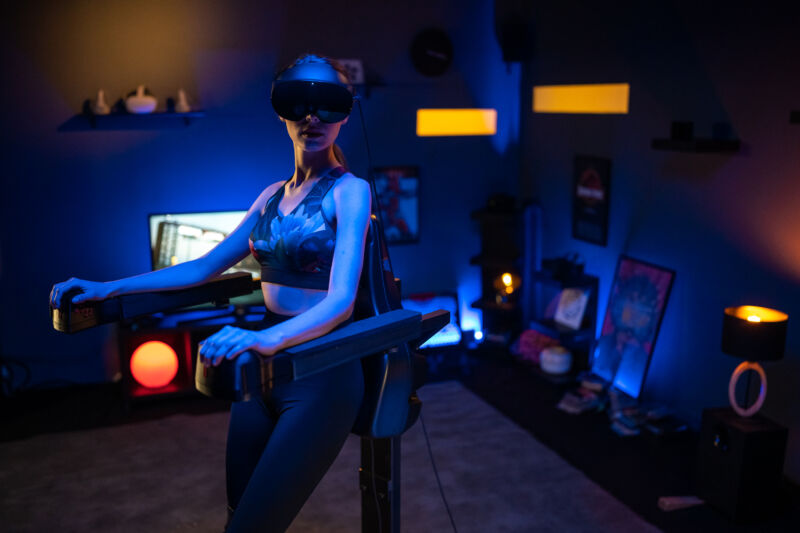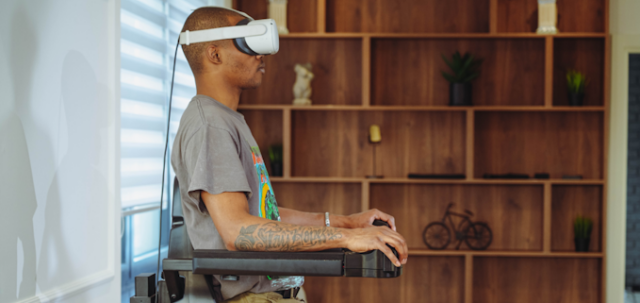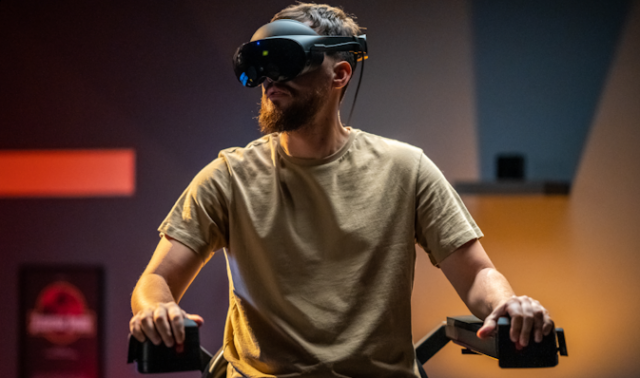
Neurosync
Anyone who has spent significant time trying to traverse large spaces in virtual reality knows that it can sometimes be a nauseating experience. The mismatch between a vestibular system telling your body it’s standing still and a VR headset telling your eyes that you’re moving often causes an almost instant upset stomach for many VR users.
For years, VR games and experiences have tried to mitigate this problem with software tricks, such as movement by “teleportation” and “snap” turning that jumps in sharp, discrete angles. But these solutions come with their own problems for games in which smoother walking motion and free rotation are important.
Rather than focusing on software, Neurosync has decided to use hardware to try to solve this problem. The company’s C-Infinity “VR Locomotion Platform” (which is currently wrapping up a successful Kickstarter campaign) promises to “effectively reduc[e] motion sickness while delivering an unparalleled true sense of movement… while also reducing fatigue.”
After trying out a prototype C-Infinity in my home office, I found it largely lived up to this promise in some of VR’s most stomach-upsetting games. But the setup’s overengineered controls and sheer size and cost make it a solution that I can only recommend to a very specific audience.
Rest your back
Installing the C-Infinity in your VR playspace is like installing a serious, bulky piece of furniture. Out of the box, it took me about an hour of serious fiddling with wrenches and screws to fit together the massive, heavy pieces that make for what’s likely the world’s most solidly built VR controller.

Neurosync
At the base of the C-Infinity is a roughly 19-by-24-inch platform coated with grippy rubber and angled to make your body lean backward by about 10 degrees or so. That angling helps your upper body settle into a large, height-adjustable backrest, which curves slightly underneath your posterior and provides a bit of vertical support while standing on the base.
While it looks awkward at first glance, it’s quite easy to settle into a comfortable half-standing, half-sitting, half-leaning position with the C-Infinity (yes, the position has three halves; what’s your point?). It’s a design that brings the perspective and freedom of stand-up VR experiences while limiting the fatigue from needing to stand fully upright for longer VR sessions.
Aside from support, the backrest also serves as part of C-Infinity’s control system. A spring-loaded pivot lets you easily twist a few degrees to the left or right, and that movement sends a USB signal that can be used to turn your perspective in the game.

Neurosync
Besides offering a nice, hands-free control addition, this twisting action is a big part of why C-Infinity is less nauseating than simply turning with an analog stick. There’s something about the physical twisting motion that primes your body to be ready for your entire perspective to swing to one side, even without software-based anti-nausea tricks. It’s a bit like you’re leaning to turn on a motorcycle or listing to one side in a theme park simulator.
In practice, though, using a full upper-body twist to control your in-game turning is a hit-or-miss affair. In a game like Doom VFR, I found it quite enjoyable to glance to one side and then give a quick twist to line myself up for more demon blasting. In a game like Windlands, though, the controls felt much too touchy, both starting and ending my in-game turns later than I wanted, resulting in a lot of delayed overturning. In other VR games, the turning controls didn’t seem to work, and I had real trouble figuring out how to manipulate the settings to enable the feature.




















+ There are no comments
Add yours